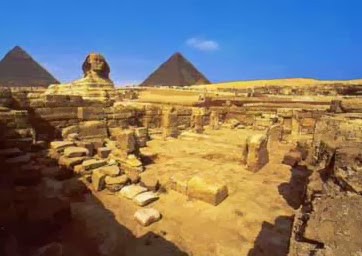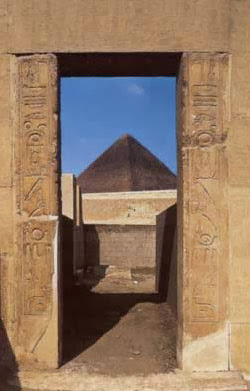The Great Sphinx is, like many other monuments in Egypt, a complex rather than simply a single colossal statue. At the Sphinx on the Giza Plateau near Cairo, there are actually two Sphinx temples. One of them, directly in front of the Sphinx, dates to the time when the Sphinx monument was built, while the other is of New Kingdom construction. In the older of the two temples, the core blocks are of the same generally poorer quality and more easily eroded limestone as the body of the Sphinx. Thus these temple can be regarded as contemporary with the carving of the monument. It should also be noted that the same core blocks also make up Khafre's lower, or valley temple, and thus place it, the Sphinx and the Sphinx temple in the same date range.
Hence, it was probably built by the same men who constructed the Pyramid temples of Khafre and is in fact almost an exact copy of the court of Khafre's mortuary temple. In fact, Khafre's lower temple was at one time thought to be the Sphinx Temple. The two temples are similar in size and both face east in a north-sought alignment. Each has a pair of north and south entrances in their eastern facades. Both temples were faced, inside and out, with finely dressed pink granite form Aswan in the far south of Egypt, and paved with alabaster.
The Sphinx temple, which was built on a terrace eight feet lower than the floor of the Sphinx, is very ruined now, with little of its granite facing left and little of its alabaster floor. Any inscriptions it may once have carried, which might have told us much about its purpose, are long gone. Only the eroded limestone core of the structure remains, in part. It is enough to show that this temple once boasted a central court, about 46 meters by 23 meters, which was open to the sky and afforded a good view of the Sphinx. Offerings would have been made on an altar in the court, which was paved with white alabaster. There was also an interior colonnade of rectangular pillars. Large recesses in the inside eastern and western walls suggest the original presence of cult statues.
The temple has two entrances on the east, one on the north, and the other on the south. These may represent doorways for Upper and Lower Egypt. There was no immediate access to the Sphinx from inside the temple. Its western wall was cut to a height of up to 2.5 meters from the living rock, and thereafter topped with limestone blocks. It was necessary to go by passages to the north and south of the temple to reach the Sphinx. There is evidence that this temple of the Sphinx was never finished, and perhaps never even used.
In fact, it is striking that, in the hundreds of Old Kingdom tombs at Giza, Egyptologists have not been able to unearth any titles of priests or priestesses that clearly belong to the Sphinx temple. The temple, which was uncovere
d at the beginning of the 20th century, had large boulders thrown both inside and outside. The Antiquities Department of Giza moved these two to eight ton stones and placed them in their appropriate locations with respect to the temple's original plans. Not long ago, cracks in the walls of the temple have been restored with mortar consisting of lime and sand.
New Kingdom pharaohs, ruling a thousand years after Khufu and Khafre, built new temples close to the Sphinx, who had become in their time (whatever his original significance may have been) a god in his own right. In the latter days of ancient Egypt, two thousand years after Khufu and Khafre, an atavistic passion for an idealized and (not surprisingly) misremembered past led to more rebuilding on the Giza site and fresh interpretations of the origin and meaning
of the Sphinx. During the New Kingdom the Sphinx was called Horem-akhet, "Horus of the Horizon".
Hope you you enjoyed reading my post & found it
useful
You may be also interested in






No comments:
Post a Comment